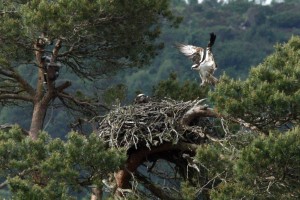Osprey Diary 5th May: Osprey Nests and their Rivalries
Location, Location , Location- Osprey Nests and their Rivalries
The Lowes Ospreys return each year at Loch of the Lowes to a carefully reinforced nest site that will survive for many decades- these canny birds know a good thing when they see it. They have found a nest site in a prime location that meets the three requirements that lead to breeding success and will allow these birds genes to be inherited for generations. These include:
- The need to nest near food, meaning water – 0 to 5 kilometres from water is ideal. Lowes is one of a chain of five lochs and the fishing potential here is fantastic, with good water quality.
- The area around the nest is open – the nest tree is a Scots Pine with sprawling branches that towers above its neighbours. This gives the birds a clear line of site for surveillance and ease of landing. Because of their large wingspan these birds are not manoeuvrable in tight spaces. If an Osprey does choose a live tree it is generally flat-topped, with lateral branches- providing stability and making nest building easy. Scots pine are by far the favoured nest tree in Scotland for this reason.

- A third and critical nest requirement is safety from predators – the fact that many artificial nest sites are difficult to climb allows the birds an added element of safety. This search for safety explains why so many Ospreys nest high in trees and on inaccessible rock pinnacles and cliffs. Curiously Scottish Ospreys have not been known to cliff nest, whereas in other parts of the world this is commonplace. Other populations are drawn to small islands where ground predators have never colonised and here they construct ground eyries. Amazingly over half the world’s Ospreys are island nesters and this tells of the prime importance of safety.
The advantages to selecting a nest site carefully cannot be under-estimated and prime site nests can become the ground of fierce battles as individuals try to hold onto or usurp established nests. This becomes a more frequent occurrence as Osprey densities increase, which we are seeing in some parts of the UK now. Dominance challenges can occur at any point throughout the breeding season.
Here at Lowes this battle for nest supremacy has been acted out early in the breeding season both this year and last:
Last year our resident male began to bond and mate with an un-ringed female who arrived on the 26/03/2013. As a couple both contributed to nest building centred on the established nest tree. When our resident female arrived on the 30/03/2013 this female was promptly driven off in an immediate challenge from our resident female.
This year a similar scenario unfolded as our male again began to bond, courtship feed and nest build with an unknown female who arrived on the 26th March 2014. Interestingly before this female arrived our male – having had 5 days to tidy the established nest tree began to bring in and arrange nest materials to an alternative nest site in what is fondly known as the Flat-Top Tree, a flat topped conifer fairly close to the established nest. By the 30th March the male seemed to be channelling his major energy into this alternative nest and female, bringing in fish deliveries and over 20 sticks on 1 day. When the resident female returned on the 31st she dive bombed the pair on the flat top tree and gave chase aerially to the other female.
In both years the rival female bird has given way to our veteran female immediately and has not returned. Perhaps her long standing bond with the site makes her a formidable opponent- the longest and fiercest battles over nests seem to be between newer, young birds with more ‘equal claims’ to the disputed nest.
These dramas are also happening at other sites across the country. At the MWT Cors Dyfi Osprey Project, Glasni, a veteran female carried out a five day campaign to rid her established nest of Blue 24 in a fierce encounter. This really impressive footage can be seen on their blog at http://www.dyfiospreyproject.com/blog and at: http://www.youtube.com/watch?v=EMiM-5KkhII&feature=player_embedded
Males can also be itinerant intruders and fight rivals over nests. At the Rutland water Osprey Project, Male 28 (10) was driven away from nest by male 33(11) leaving Maya – the resident female – to incubate eggs from this union by herself. Unfortunately this proved unsustainable and the victorious male ejected Mayas’ eggs whilst she was away fishing for herself.
All this shows us that nest ‘politics’ can be dramatic and surprising, but the fact that we have enough ospreys now in our recovering UK population for there to be competition at nest sites is something to be celebrated!
Kirstin Mair , Species Protection Officer
Help protect Scotland’s wildlife
Our work to save Scotland’s wildlife is made possible thanks to the generosity of our members and supporters.
Join today from just £3 a month to help protect the species you love.
Preface
Location, Location , Location- Osprey Nests and their Rivalries The Lowes Ospreys return each year at Loch of the Lowes to a carefully reinforced nest site that will survive for …
